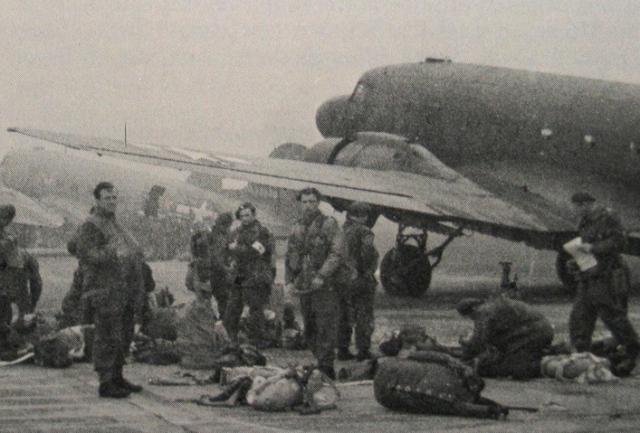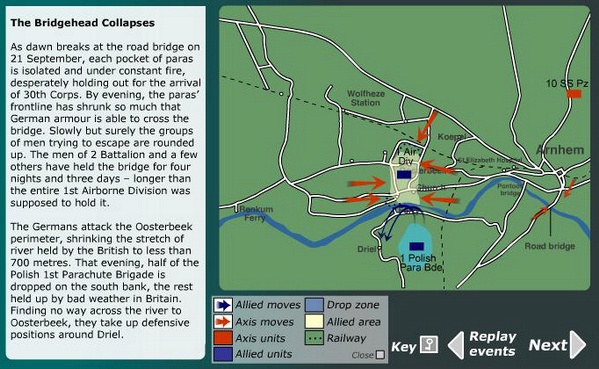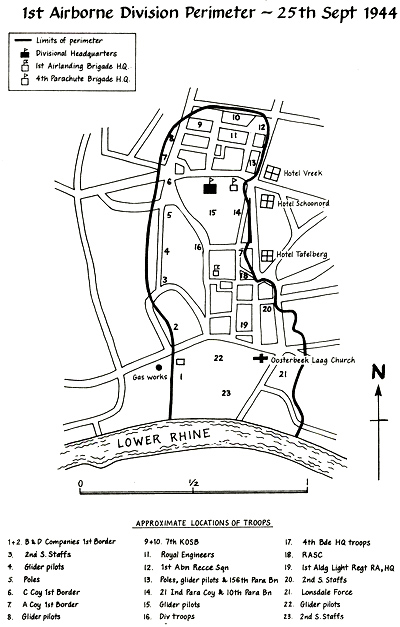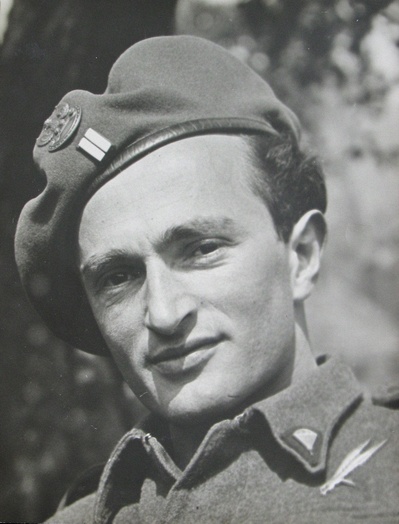In September 1944, only three months after the D-day landings in Normandy, British Field Marshal Montgomeryplanned the ambitious “Operation Market Garden” to penetrate deep inside German-occupied Holland and capture strategic bridges over the Rhine River. Opening a thrust into the Ruhr, Germany’s industrial heartland, it was thought that this operation could inflict a fatal blow to a retreating and disorganised German Army and thus greatly speed the end of the war. This battle featured in the Richard Attenborough film “A Bridge too Far” (1977).
In preparation for the mission, David’s regiment moved to Peterborough, England, to be close to the airfields that would be used for the assault. The airlift of 1st Airborne Division begins on 17th September 1944 and the troops landed on the first day are to take and hold the road bridge at Arnhem and secure and protect the dropping and landing zones for the further troops arriving over the next two days when the surprise element would no longer be an advantage. The 1st Polish Independent Parachute Brigade are to land on the third day at a position south of the main Arnhem bridge, cross the river and deploy to the eastern suburbs of the town leading to the complete establishment of a bridgehead on the northern side of the river, awaiting the arrival of troops from the south.
Preparation for Battle of Arnhem; David Salik in centre with Red Cross armband
However, the expectation of a weak German defence is quickly confounded, notably by the presence of two SS Panzer divisions. On the first day of the operation, a single battalion is able to reach the Arnhem bridge, the others being blocked by German resistance, but can only secure its northern side. On the 2nd day more troops arrive as planned and join forces with the battalions planning to attack Arnhem to relieve the battalion holding the bridge. However, on the 3rd day, troops are caught in very heavy fire and one battalion is almost wiped out. The remaining troops are forced to drop back to Oosterbeek. Due to a radio blackout, essential supplies are dropped to enemy-captured landing zones and result in tragic loss of aircrews. The planned Polish drop zone has also been overrun, forcing a change of location. However, these troops are being greatly delayed from leaving England by fog. By the 4th day, the troops defending the Arnhem bridge have to be abandoned and a defensive perimeter is set up around Oosterbeek which would also form a bridgehead on the northern bank of the river for any subsequent crossings from the south using the ferry at Heveadorp.
Thursday 21st September is the 5th day of the operation. The Arnhem bridgehead collapses and the Oosterbeek perimeter is under heavy German attack. Only then are the Polish paratroopers, including David Salik, dropped near Driel on the south side of the river. Commanded by Major General Stanislaw Sosabowski, only about 750 men actually reach Holland as forty-one aircraft, carrying 500 men, are turned back due to bad weather. During the drop, they are shot at “like ducks” by Germans on ground but once landed are helped out with their equipment by Dutch partisans who appear from the fields.
Map of the 5th day of operations (from an animated map of the Battle of Arnhem on the BBC website: link)
With the Heveadorp ferry missing, believed sunk, the Poles cannot cross the river and so form a defensive area near Driel. They are instructed to return to the river that night when rafts would be sent but none appear and no Poles cross. On the following night, after the 6th day, four inflatable dinghies and wooden rafts are used to ferry six men at a time and supplies across the river. However, the crossing comes under heavy mortar fire, two dinghies are destroyed and heavy casualties are suffered. Only 50 Poles manage to reach the northern bank; David Salik is among them, having pushed himself forward. On the following night, a further 250 Poles cross the river.
On the 7th day of the operation, David finds himself in Oosterbeek with his unit, jumping from house to house under enemy fire in order to reach their allotted position and so provide needed reinforcement for the perimeter defence. David serves in the Para Field Ambulance of the 3rd Parachute battalion, commanded by Lieutenant Bereda. Moving in small groups, the commanding officer is not with the troops at all times. David takes the responsibility of ordering men to cross from house to house. In one incident, soldier Konstanty Wesolowicz was shot by sniper fire while crossing and it was not possible to try to save him. David says that for years later he could not bear this memory, knowing that he had ordered the man to cross and he had been killed. However, after the man, David too has to jump and anyone of the unit could be killed at any time.
The soldiers operate in groups of 10-20 per house. David’s mission is to help the wounded and so he is only armed with a Colt revolver. In the absence of doctors, David sorts between the wounded that must return to action, those he can treat and those that are seriously injured. On the 8th day of operations a short ceasefire allows the wounded to be evacuated. David does not recall the ceasefire but he remembers that those soldiers in urgent medical need were accompanied to the hospital between Oosterbeek and Arnhem, the inconvenience of this arrangement being that the accompanying soldier became prisoner to the Germans.
The ground troops arrived from the south, XXX Corps, who had been totally unable to reach the Arnhem bridge as planned on the 3rd day are providing valuable artillery support to break up enemy attacks on the perimeter. However, the situation of the 1st Airborne Division is so dire that serious consideration is given to its withdrawal. In the next 24 hours, either a complete brigade is passed across the river and a bridgehead is established or withdrawal takes place.
The positions of the different troops of the 1st Airborne Division in the Oosterbeek perimeter on the 9th day of the operation is shown below. The evacuation of the entire zone, codenamed Operation Berlin is to take place this evening.
Map showing the Oosterbeek defensive perimeter on the 9th day of Operation Market Garden (reproduced from [3])
David recalls the evacuation taking place in a very orderly manner. Equipment and personal effects have to be left behind, but the troops sweep up and leave things neatly in order to show the Germans that they are not leaving in panic. The heavily wounded that cannot be transported are left behind in a basement with vials of morphine to ease their suffering until the Germans arrive. For the evacuation, the troops blacken their faces with boot polish and cover their boots with rags. They form a human chain leading through the forest to the river bank. In the pitch black conditions, troops constantly bump into the soldier in front when he stops. A password system is in operation to identify persons; on saying “Churchill”, the reply is “Montgomery”.
Reaching the river bank, David finds masses of people waiting for too few boats to cross the river. Fearing persecution if he is to be made prisoner by the Germans, David buries his gold Star of David pendant in a field. Many troops try to swim across the river but the weather is very bad and strong currents cause many to drown, including a Polish priest known to be an excellent swimmer. David again manages to “squeeze onto” a boat. He is one of few who had managed to cross the river both ways, having landed at Driel and now returning there. On the other side of the river, troops look after the wounded and recuperate. By midday of the 10th day of the operation, the survivors are in Nijmegen and 4 days later, on 30th September, they return to England.
By the end of the Arnhem operation, 2400 troops had been evacuated while 7200 of their number were killed, wounded, captured or missing. Despite Montgomery claiming that the operation had been 90 per cent successful, the principal aim of establishing a bridgehead over the Rhine to thrust into the Ruhr region of Germany had failed.
David Salik was promoted from the rank of Corporal to Sergeant after Arnhem. He was decorated for bravery in action, receiving the Field Para badge, the Army Medal, the Polish Bronze Cross of Merit with Swords and four British medals.
References
[1] By Air to Battle, The Official Account of the British First and Sixth Airborne Divisions, His Majesty’s Stationary Office, 1945.
[2] Arnhem 1944, Janusz Piekalkiewicz, Ian Allen Ltd, London, 1977.
[3] ARNHEM, A Tragedy of Errors, Peter Harclerode, Caxton Editions, London, 2000.



